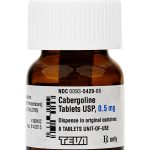Can I Take Cabergoline During Periods?

Cabergoline, a dopamine agonist, is commonly prescribed for medical conditions such as hyperprolactinemia, prolactin-secreting adenomas, and certain disorders related to the overproduction of the hormone prolactin. As women considering or currently using cabergoline may wonder about its safety during menstruation, this article aims to provide a comprehensive guide addressing this question.
We will delve into the pharmacology of cabergoline, its primary uses, potential effects on menstrual cycles, and considerations for women taking this medication during their periods.
What is Cabergoline?
Cabergoline belongs to the class of medications known as dopamine agonists. It works by activating dopamine receptors in the brain, inhibiting the secretion of prolactin – a hormone responsible for lactation and the regulation of the menstrual cycle. Cabergoline is commonly prescribed to treat hyperprolactinemia, a condition characterized by elevated levels of prolactin in the blood. It is also used in the management of prolactin-secreting adenomas, tumors that affect the pituitary gland and can lead to disruptions in hormonal balance.
Primary Uses of Cabergoline
1. Hyperprolactinemia: Cabergoline is often prescribed to address hyperprolactinemia, a condition marked by excessive levels of prolactin. Elevated prolactin can disrupt the normal menstrual cycle, leading to irregular periods or amenorrhea (absence of menstruation). By reducing prolactin levels, cabergoline helps restore hormonal balance.
2. Prolactin-Secreting Adenomas: Prolactin-secreting adenomas are benign tumors of the pituitary gland that can cause hyperprolactinemia. Cabergoline is effective in reducing the size of these tumors and normalizing prolactin levels, thereby alleviating associated symptoms and restoring menstrual regularity.
Effects of Cabergoline on Menstrual Cycles
1. Normalization of Menstrual Function: For women with hyperprolactinemia or menstrual irregularities associated with prolactin-secreting adenomas, cabergoline can play a crucial role in restoring normal menstrual function. As prolactin levels decrease, the inhibitory effects on the ovarian cycle diminish, allowing for improved hormonal regulation and more regular menstrual cycles.
2. Amenorrhea Reversal: Amenorrhea, a condition characterized by the absence of menstrual periods, is often linked to elevated prolactin levels. Cabergoline can contribute to the reversal of amenorrhea by addressing the underlying cause – hyperprolactinemia. Women may experience the resumption of regular menstrual cycles with the use of cabergoline.
3. Improvement in Fertility: In cases where hyperprolactinemia has led to fertility issues, cabergoline can be instrumental in improving reproductive outcomes. By restoring ovulatory function and menstrual regularity, women taking cabergoline may have an increased likelihood of conceiving.
Taking Cabergoline During Menstruation
Cabergoline is typically taken orally, and the timing of administration may vary based on individual prescriptions. Women prescribed cabergoline should follow their healthcare provider’s instructions regarding the timing of medication intake, which may or may not coincide with their menstrual cycle.
Cabergoline, available in the form of 0.5 mg oral tablets, is a medication prescribed for conditions such as hyperprolactinemia and prolactin-secreting adenomas. To ensure its safe and effective use, it is crucial to follow specific guidelines on how to take cabergoline.
1. Dosage and Frequency: Cabergoline is typically initiated at a starting dose of 0.25 mg twice a week for adults. However, your healthcare provider will tailor the dosage based on individual factors, particularly your prolactin levels. The maximum recommended dose is 1 mg twice a week. It’s essential to strictly adhere to the prescribed dosage and frequency outlined by your healthcare professional.
2. Administration with or without Food: Cabergoline can be taken with or without food, providing flexibility for individuals with different preferences or dietary requirements. Whether you choose to take it before, during, or after meals, consistency in administration is key to maintaining stable drug levels in your system.
3. Prescription Label Instructions: Carefully read the prescription label that accompanies your medication. The label provides specific instructions on how to take cabergoline, including dosage, frequency, and any additional considerations. Following these instructions diligently ensures that you are taking the medication as intended.
4. Avoid Changing Doses Independently: It is crucial not to alter the prescribed dosage without consulting your healthcare provider. Avoid changing from higher doses to lower doses or vice versa without professional guidance. Any adjustments to the dosage or frequency should be made in collaboration with your healthcare professional to ensure optimal therapeutic effects.
5. Gradual Dose Adjustment: Your healthcare provider may initiate treatment with a low dose and gradually increase it over time. This approach, especially relevant for individuals aged 65 and older, helps monitor your body’s response to the medication. Older individuals may clear cabergoline more slowly, increasing the risk of side effects. The gradual dose adjustment allows for better tolerance and minimizes potential adverse reactions.
6. Consultation with Healthcare Provider: Before initiating or continuing cabergoline during menstruation, it is crucial for women to consult with their healthcare providers. The healthcare provider can assess the specific medical condition, adjust the dosage if necessary, and provide guidance on the most appropriate timing for taking the medication.
7. Potential Side Effects: While cabergoline is generally well-tolerated, it can be associated with side effects. These may include nausea, dizziness, fatigue, and gastrointestinal symptoms. Women taking cabergoline during menstruation should be mindful of any side effects and promptly report them to their healthcare provider.
8. Pregnancy Considerations: It is important for women of childbearing age to discuss pregnancy plans with their healthcare provider while taking cabergoline. Though cabergoline is not typically recommended during pregnancy, individual cases may vary, and healthcare providers can provide personalized advice based on the specific medical situation.
9. Monitoring and Follow-Up: Regular monitoring, including prolactin levels and menstrual cycle regularity, is crucial for women taking cabergoline. Healthcare providers may schedule follow-up appointments to assess the medication’s effectiveness, make any necessary adjustments, and address any concerns or side effects.
Conclusion
In conclusion, cabergoline can be a valuable medication for women dealing with hyperprolactinemia or menstrual irregularities associated with prolactin-secreting adenomas. By restoring hormonal balance, cabergoline contributes to the normalization of menstrual cycles and improvement in fertility. While the timing of medication intake during menstruation may vary, it is essential for women to follow their healthcare provider’s instructions and communicate any concerns or side effects promptly. Consulting with a healthcare provider ensures that the use of cabergoline aligns with individual health goals and contributes to the overall well-being of women seeking to regulate their menstrual cycles.





